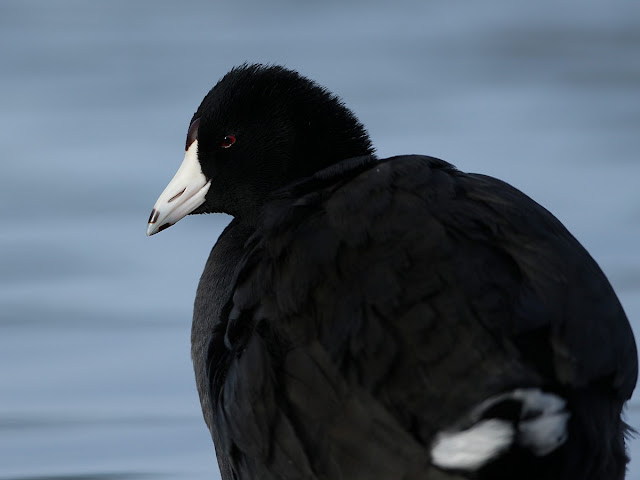Nov. 22
Lost Lagoon, Stanley Park
Hooded Merganser
Many ducks start displaying themselves for mates in November; and Hooded Mergansers are among them. The males puff up their crowns and lean back when swimming forward, calling from time to time. The females also have crowns, but do not join the show, they only swim around examining possible grooms. Recording of calls are on All About Birds.
 |
| Hooded Merganser male |
 |
| Hooded Merganser males |
 |
| Hooded Merganser |
a funny-looking face
 |
| Hooded Merganser male |
 |
| Hooded Merganser female |
Common Merganser
about a dozen of them spent the whole morning chasing whichever bird that caught a fish.
 |
| Common Merganser males |
Double-crested Cormorant
no eyebrows in November, but they have beautiful blue-green eyes.
 |
| Double-crested Cormorant |
American Coot
The American species has a dark red front. Eurasian Coots do not.
 |
| American Coot |
Belted Kingfisher
clearly the bird weights less than 250 kg as the bar is supporting her quite well.
 |
| Belted Kingfisher female |
Great Blue Heron
Stanley must be one of the best locations for observing these big birds. They nest, rest, hunt and stay in the park.
 |
| Great Blue Heron |
Pacific Wren
I find it challenging to get good pictures of Pacific Wrens. They like to jump around in bushes and rarely stop for more than 5 seconds.
 |
| Pacific Wren |
Golden-crowned Kinglet
The leaves in the background suggested winter was on its way.
 |
| Golden-crowned Kinglet |
Boundary Bay
Northern Harrier
I can prove that at least 2 birds were present. The first one's tail was forked.
 |
| Northern Harrier |
The second one's complete.
 |
| Northern Harrier |
Short-eared Owl
Snowy Owl
Snowy! I did not expect the Harrier to flush this Snowy out of the grass. When the Harrier was first circling this area, we did not know exactly why, until this white spot popped up. The arrival of SNOW marks the beginning of winter. The acronym of SNowy OWl is SNOW.
 |
| Snowy Owl and Northern Harrier |
 |
| Snowy Owl and Northern Harrier |
Iona Island
and then another surprise. Even more unexpected, a Burrowing Owl was seen in the morning! When my friends and I heard the news, it was already not new. It was one hour to night. We decided it was worth a try. We made it to Iona from Boundary Bay before dark it became too dark to see. About 20 people were already at the site, but they said there was no sight of the owl since it was first reported. Most people left soon after, but then Hank relocated it. It was truly incredible how he saw it in the low light, with no optical aid and immediately identified a little head from some distance away as the owl. This was the first Burrowing Owl sighting I heard in metro Vancouver Since I moved here. And the only other time I've seen this species is in Othelo in Washington State.
 |
| Burrowing Owl |
 |
| Burrowing Owl |
Dec. 22
Queen Elizabeth Park
I received my presents, 2 lifers, half a week before Christmas. Redpolls had always been one of the top bird I wanted to find; for me, they represent the elusive north. British Columbia is as far north as I have been in Canada so I have been trying to see some northern birds here. Finally this year, a relatively big wave of Redpolls have migrated farther south than they usually do. The flock at QE park contains not one, not two, but 5 Common Redpolls and a Hoary Redpoll, which is even rarer.
Red and white are Christmas colours which make Redpolls Christmas birds.
Common Redpoll
more rosy, streaked overall than Hoary
 |
| Common Redpoll |
The undertail covert has many streaks
 |
| Common Redpoll |
Hoary Redpoll
it is so hard to tell theses species apart that they may be considered one species in the future.
the flanks are finely streaked, pretty much no pink on the breast
 |
| Hoary Redpoll |
undertail covert i almost completely white.
 |
| Hoary Redpoll |
Just a check, both left and right sides are finely streaked.
 |
| Hoary Redpoll |
Dec. 23
Ambleside Park
Belted Kinfisher
the signature posture
 |
| Belted Kingfisher female |
Bonaparte's Gull
 |
| Bonaparte's Gull |

No comments:
Post a Comment